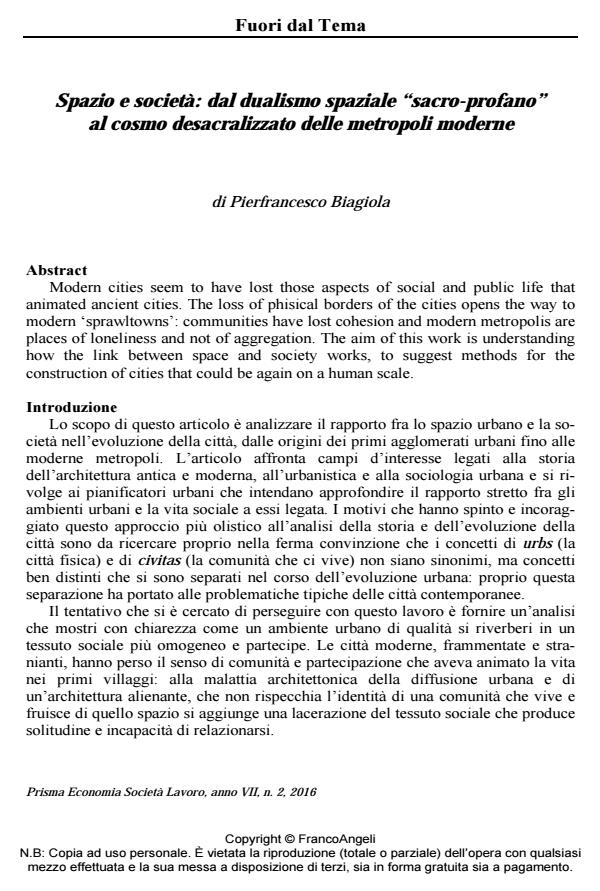Spazio e società: dal dualismo spaziale "sacro-profano" al cosmo desacralizzato delle metropoli moderne
Journal title PRISMA Economia - Società - Lavoro
Author/s Pierfrancesco Biagiola
Publishing Year 2017 Issue 2016/2 Language Italian
Pages 12 P. 183-194 File size 165 KB
DOI 10.3280/PRI2016-002013
DOI is like a bar code for intellectual property: to have more infomation
click here
Below, you can see the article first page
If you want to buy this article in PDF format, you can do it, following the instructions to buy download credits

FrancoAngeli is member of Publishers International Linking Association, Inc (PILA), a not-for-profit association which run the CrossRef service enabling links to and from online scholarly content.
Modern cities seem to have lost those aspects of social and public life that animated ancient cities. The loss of phisical borders of the cities opens the way to modern ‘sprawltowns’: communities have lost cohesion and modern metropolis are places of loneliness and not of aggregation. The aim of this work is understanding how the link between space and society works, to suggest methods for the construction of cities that could be again on a human scale.
- AA.VV., (2010) Town planning in Denmark 1945-2010, GO Forlag, Copenaghen
- Augè M., (2009) Nonluoghi. Introduzione a una antropologia della surmodernità, Elèuthera, Milano
- Benevolo L., (1993) La città nella storia d’Europa, Laterza, Bari
- Deplano C., (2009) Antropologia urbana. Società complesse e democrazie partecipativa, EdicomEdizioni, Monfalcone
- Eliade M., (2009) Il sacro e il profano, Universale Bollati-Boringhieri, Torino.
- Gehl J., Svarre B., (2013) How to study public life, Island Press, Washington
- Gehl J., Gemzøe L., (2004) Public Spaces, Public Life, DAC Press, Copenaghen
- Lorenzo R., (2006) La città sostenibile – partecipazione, luogo, comunità, Elèuthera, Milano
- Mumford L., (2013) La città nella storia, Castelvecchi, Roma
- Musco F., (2009) Rigenerazione urbana e sostenibilità, FrancoAngeli, Milano
- Wiking M., (2011) Copenhagen – Beyond Green: the socioeconomic benefits of being a green city, Green Growth Leaders, Copenaghen
- Tham K., (1997) The human in architecture, working paper incompleto non pubblicato, Malmö
- Simmel G., (1996) La metropoli e la vita dello spirito, Armando Editore, Roma
Pierfrancesco Biagiola, Spazio e società: dal dualismo spaziale "sacro-profano" al cosmo desacralizzato delle metropoli moderne in "PRISMA Economia - Società - Lavoro" 2/2016, pp 183-194, DOI: 10.3280/PRI2016-002013